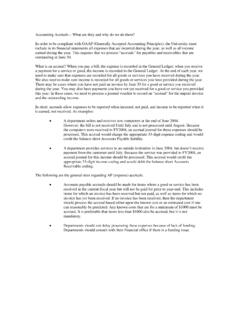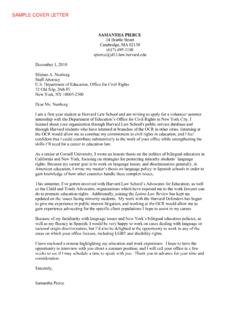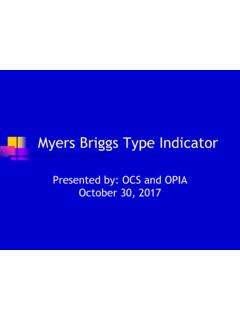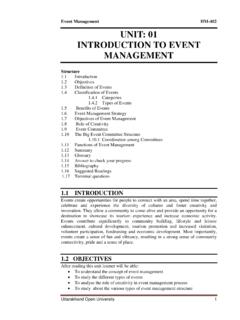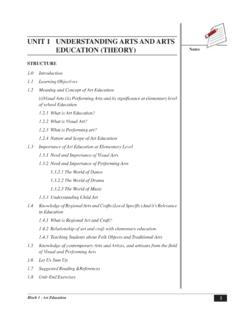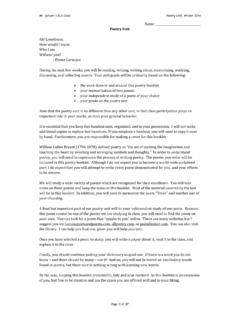Transcription of Introduction to Quantitative Methods
1 Introduction to Quantitative Methods Parina Patel October 15, 2009. Contents 1 Definition of Key Terms 2. 2 Descriptive Statistics 3. Frequency Tables .. 4. Measures of Central Tendencies .. 5. Measures of Variability .. 5. Summary of Central Tendencies and Variability .. 6. 3 Inferential Statistics 6. More Definitions and Terms .. 6. Comparing Two or More Groups .. 10. Association and Correlation .. 12. Explaining a Dependent Variable .. 13. Assumptions .. 14. List of Tables 1 Frequency Table Socioeconomic Class .. 4. 2 Crosstab of music Preference and Age .. 5. 3 Summary of Univariate Statistics .. 6. 4 Comparing Group Means.
2 10. 5 Association and Correlation .. 12. 6 Explaining a Dependent Variable .. 13. 1. Empirical Law Seminar Parina Patel 1 Definition of Key Terms 1. Unit of Analysis (also referred to as cases): The most elementary part of what is being studied or observed. Some examples include individuals, households, court cases, countries, states, firms, industries, etc. 2. Variables: Concepts, characteristics, or properties that can vary, or change, from one unit of analysis to another. Please note that all variables must vary, if there is no variation among the different cases then it is not a variable. Some examples of variables include gender, social class, education, age, level of public enforcement, type of bankruptcy, etc.
3 (a) Dependent Variable DV: Variables whose change the researcher wishes to explain (b) Independent Variable IV: Variables that help explain the change in the dependent variable 3. Hypothesis: An empirical statement which seeks to test the relation- ship between at least two variables. For instance, As levels of public enforcement increases, levels of stock development also increases. This hypothesis has two variables: (1) public enforcement independent vari- able, and (2) stock development dependent variable. 4. Levels of Measuring Variables (a) Nomial: A nominal variable has qualitative categories that can- not be ranked in a meaningful way in terms of degree or mag- nitude.
4 Examples of nominal variables include RACE, TYPE. OF BANKRUPTCY, TYPE OF CORPORATION, NAME. All of these variables have qualitative categories that cannot be or- dered in terms of magnitude or degree. This is the least powerful type of variable. 1. (b) Ordinal: An ordinal variable has qualitative categories that are ordered in terms of degree or magnitude. Examples of a nomi- nal variable include CLASS or DEGREE OBTAINED. The vari- able DEGREE OBTAINED may include the following categories: 1. Alphabetizing the categories does not count as ordering the variable, because the ordering has to be in terms of degree or magnitude. 2. Empirical Law Seminar Parina Patel None, High School Diploma, College/University Degree, Masters, Advanced Degree (JD/PHD/MD).
5 All of these categories are qual- itative and are ordered in terms of the amount of education each individual has completed. (c) Interval/Ratio: An interval variable has Quantitative values (or numbers). Some examples of interval variables include AGE (in years), NUMBER OF SHARES OUTSTANDING, and AMOUNT. IN DEBT (in dollars). For all of these variables the response is going to be a number or value. This is most powerful type of variable because you can do the most with it statistically. Note that if a variable has qualitative categories that ARE ordered and there are numerical values assigned to each category which are also ordered, we can treat this variable like an interval level vari- able.
6 An example would be questionnaire that asks respondents about their feelings towards President Obama's handling of the economy on a scale of 1 to 5 where (1=very bad job, 2=bad job, 3=neither bad nor good, 4=good job, and 5=very good job). The respondents are asked to choose a category that is ordered, but since it has ordered numbers attached to the categories, we can treat it as an interval level variable with some restrictions. 2. (d) Dichotomous/Dummy: A dichotomous variable is a variable with two (and only two) categories. These categories can be qualitative or Quantitative values. 3. 2 Descriptive Statistics Descriptive statistics are often used to describe variables.
7 Descriptive statis- tics are performed by analyzing one variable at a time (univariate analysis). All researchers perform these descriptive statistics before beginning any type of data analysis. 2. One such restriction being the dependent variable in regression analysis. In order to perform regression (see section ) your dependent variable must be a proper interval variable. 3. It is possible to convert nominal variables into numerous dichotomous/dummy vari- ables. 3. Empirical Law Seminar Parina Patel Frequency Tables Frequency tables are a detailed description of the categories/values for one variable. A frequency table most often includes all of the following: 4.
8 1. Absolute frequency (or just frequency): This tells you how many times a particular category in your variable occurs. This is a tally, count, or frequency of occurrence of each individual category/value in the table. 2. Relative frequency (or percent): This tells you the percentage of each category/value relative to the total number of cases. 3. Cumulative frequency: This is simply a cumulation of the relative fre- quency for each category/value. Table 1 provides an example of a frequency table for an ordinal variable (note it is ordinal because the categories are qualitative and ordered). named Socioeconomic Class. If there were numbers assigned to each category that were also ordered, we could treat this as an interval level variable.
9 Table 1: Frequency Table Socioeconomic Class Socioeconomic Class Frequency Percent Cumm. Percent Upper 50 Upper Middle 150 Middle 300 Lower Middle 150 Lower 50 100%. Total 700 100%. 4. Crosstabulations: This is also referred to as a grouped frequency table for two variables. A crosstab simply presents the absolute frequency broken down by categories of two or more variables. It is also possible to find percentages in these types of tables. For instance, using the 4. The stata command for frequency is fre or tab. Before you use the fre command you need to install it onto your computer, so you need to type the following command: ssc install fre, which will install the fre command onto your computer.
10 For a frequency table of a variable named class, type either fre class or tab class . 4. Empirical Law Seminar Parina Patel example below, we can find the percentage of young people that listen to music . 5. Table 2: Crosstab of music Preference and Age AGE. Preference Young Middle Age Old music 14 10 3. News-talk 4 15 11. Sports 7 9 5. Measures of Central Tendencies Measures of central tendencies provide the most occurring or middle value/category for each variable. There are three measures of central tendencies mode, me- dian, and mean. See Table 3 for a summary of measures of central tendencies. Measures of Variability Measures of variability is defined as the dispersion (or deviation) away from the mean for each variable.




